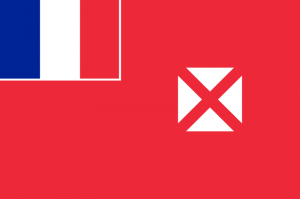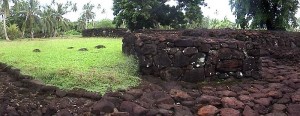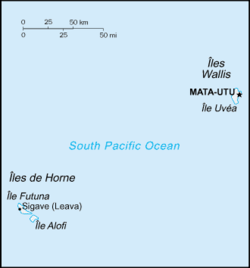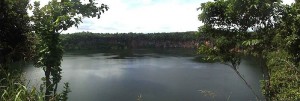Wallis and Futuna

Polynesian Seafaring: History and Hawaiian Re-creation
Captain Cook ‘discovers’ Tahiti and Hawaii. The natives tell Cook how they navigated the vast Pacific Ocean. Later commentators dispute this, and some natives of today—many decades after ravages of their culture by outsiders–decide to rebuild the ancient navigation knowledge and traditional sailing canoes to create a new legacy of wayfinding and revive the spirit of the ancestral way as they teach others to face new horizons. Herb Kawainui Kane speaks about Thor Heyerdahl and his Kon-Tiki expedition, and then the Hokule’a (Hōkūle’a)– a re-created ancient double-hulled voyaging canoe (vaka taurua) featured in this extract. Narrated by Napuanalani Cassidy.
Wallis and Futuna, officially the Territory of the Wallis and Futuna Islands (French: Wallis et Futuna or Territoire des îles Wallis et Futuna, Fakauvea and Fakafutuna: Uvea mo Futuna), is a French island collectivity in the South Pacific between Tuvalu to the northwest, Rotuma of Fiji to the west, the main part of Fiji to the southwest, Tonga to the southeast, Samoa to the east, the New Zealand–associated state of Tokelau to the northeast and to a more distant north the Phoenix Islands (Kiribati). Wallis and Futuna is not part of French Polynesia, nor even contiguous with it, as the former are located at the very opposite western end of Polynesia.
Its land area is 264 km2 (102 sq mi) with a population of about 15,000. Mata-Utu is the capital and biggest city. The territory is made up of three main volcanic tropical islands along with a number of tiny islets, and is split into two island groups that lie about 260 km (160 mi) apart, namely Wallis Islands(Uvea) in the northeast, and Hoorn Islands (also called the Futuna Islands) in the southwest, including Futuna Island proper and the mostly uninhabited Alofi Island.
Since 2003 Wallis and Futuna has been a French overseas collectivity(collectivité d’outre-mer, or COM). Between 1961 and 2003, it had the status of a French overseas territory (territoire d’outre-mer, or TOM), though its official name did not change when the status changed.
History
 Ruins of the Talietumu fort
Ruins of the Talietumu fort
Although the Dutch and the British were the European discoverers of the islands in the 17th and 18th centuries, it was the French who were the first Europeans to settle in the territory, with the arrival of French missionaries in 1837, who converted the population to Roman Catholicism. Pierre Chanel, canonized as a saint in 1954, is a major patron of the island of Futuna and the region. The Wallis Islands are named after the British explorer, Samuel Wallis.
On 5 April 1842, the missionaries asked for the protection of France after the rebellion of a part of the local population. On 5 April 1887, the queen of Uvea (on the island of Wallis) signed a treaty officially establishing a French protectorate. The kings of Sigave and Alo on the islands of Futuna and Alofi also signed a treaty establishing a French protectorate on 16 February 1888. The islands were put under the authority of the French colony of New Caledonia.
In 1917, the three traditional kingdoms were annexed to France and turned into the Colony of Wallis and Futuna, which was still under the authority of the Colony of New Caledonia.
During World War II the island’s administration was pro-Vichy until a Free French corvette from New Caledonia deposed the regime on 26 May 1942. Units of the US Marine Corps landed on Wallis on 29 May 1942.
In 1959, the inhabitants of the islands voted to become a French overseas territory, effective in 1961, thus ending their subordination to New Caledonia.
In 2005, the 50th king, Tomasi Kulimoetoke II, faced being deposed after giving sanctuary to his grandson who was convicted of manslaughter. The king claimed his grandson should be judged by tribal law rather than by the French penal system. There were riots in the streets involving the king’s supporters, who were victorious over attempts to replace the king. Two years later, Tomasi Kulimoetoke died on 7 May 2007. The state was in a six-month period of mourning. During this period, mentioning a successor was forbidden. On 25 July 2008, Kapiliele Faupala was installed as king despite protests from some of the royal clans.
Geography
 Map of the territory of Wallis and Futuna
Map of the territory of Wallis and Futuna
Wallis and Futuna is located about two-thirds of the way from Hawaii to New Zealand, at 13°18′S 176°12′WCoordinates:  13°18′S 176°12′W, (225 mi west of Samoa and 300 mi (480 km) north-east of Fiji).
13°18′S 176°12′W, (225 mi west of Samoa and 300 mi (480 km) north-east of Fiji).
The territory includes the island of Uvéa (the most populous), the island of Futuna, the essentially uninhabited island of Alofi (the population of Alofi was reportedly eaten by the cannibal people of Futuna in one single raid in the 19th century), and 20 uninhabited islets, totaling 274 square kilometres (106 sq mi) with 129 kilometres (80 mi) of coastline. The highest point in the territory is Mont Puke (on the island of Futuna) at 524 metres (1,719 ft).
The islands have a hot, rainy season from November to April and a cool, dry season from May to October. The rains accumulate 2,500 to 3,000 millimetres (98–118 in) each year. The average humidity is 80% and the temperature 26.6 °C(79.9 °F).
Only five percent of the islands’ land area is arable land; permanent crops cover another 20%. Deforestation (only small portions of the original forests remain), largely as a result of the continued use of wood as the main fuel source, is a serious problem; as a consequence of cutting down the forests, the mountainous terrain of Futuna is particularly prone to erosion. There are no permanent settlements on Alofi because of the lack of natural fresh water resources.
The two island groups lie about 260 km apart:
- Wallis Islands (Uvea), in the northeast
- Wallis Island (Uvea)
- Hoorn Islands (Futuna Islands), in the southwest
Sub-equatorial oceanic trade wind , hot and humid . The average temperature is around +26 ° C all year round and there is almost never drops below +24 ° C, and in the rainy season is held in the mark +28-32 ° C.
Rainfall is 2500-3000 mm per year in 4000 to Wallis and Futuna mm . This rain is likely at least 260 days in a year, and the humidity is 80 %. The rainy season lasts from November to April. For the same period (November to March) and the season of storms have associated with the passage over the territory of the islands of powerful tropical cyclones. A few more cool and dry season – May to October-December – due to the predominance of this period, the south- east trade winds.



